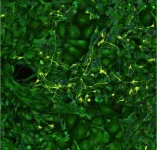(Press-News.org)
Rising temperatures have led to the growth of algal blooms in water bodies, mountainous areas, and coastal regions as far as the Arctic. Recently, pigmented snow algae have been spotted on Japan’s Mount Gassan after the winter season. The presence of such algal blooms is concerning because they reduce the reflectivity of snow-covered surfaces, resulting in faster snow melting. Additionally, the algal blooms can have unforeseen impacts on the surrounding wildlife and vegetation. The growth and color of snow algae in mountainous areas appear to differ depending on the season, elevation, and predominant vegetation. However, there is limited information on the appearance of algal blooms in the mountainous areas in Japan.
The appearance of snow algal blooms on Mount Gassan caught the attention of Nozomu Takeuchi, a Professor in the Department of Earth Sciences at Chiba University, Japan, who has decades of experience studying organisms in snowpacks and glaciers around the world. Together with Suzuki Takumi from the same faculty, Prof. Takeuchi documented the growth and composition of such blooms at different elevations on Mount Gassan. Their findings, which were published in Volume 55 Issue 1 of the journal Arctic, Antarctic, and Alpine Research, on March 13, 2023, shed light on the growth and spread of snow algal blooms in the mountainous regions of Japan.
“Although Japan has exceptionally high levels of snowfall, the presence of such organisms living in snowpacks remains unknown. This study may induce people to acknowledge the precious ecosystems in the mountains of Japan,” says Prof. Takeuchi, explaining the motivation behind their study.
The algal blooms in Mount Gassan typically appear from late March to mid-July, which is after the winter season when the snow starts to melt. During this period, the researchers collected colored snow samples at seven different locations on Mount Gassan. The locations spanned a range of altitudes, from 780 to 1656 meters above sea level (a.s.l), encompassing heavily forested areas at lower altitudes and alpine grasslands at higher elevations.
The effects of both season and altitude on algal blooms became quickly apparent during the sampling phase. In May, the researchers observed mostly green-colored snow at lower elevation sites (180-1016 m a.s.l). In June, the green-colored snow was found further up the mountain, and patches of red-colored snow were found at the highest survey location, at an elevation of 1656 m a.s.l. By July, the algal blooms on this site had multiplied, resulting in the researchers finding numerous patches of red-colored snow. This trend indicates that algal growth begins in the lower forested areas and spreads to the upper alpine zone as the seasons get warmer. Their observation was confirmed by laboratory chlorophyll analysis, which revealed that chlorophyll-a concentration in the snow samples collected across the different sampling sites increased from May to July.
To find out why this happens, the researchers analyzed the snow samples for soluble chemical ions. Their findings revealed that the concentration of algal blooms corresponded with the presence of nutrients associated with the growth of algal blooms, such as phosphate (PO43−), ammonium (NH4+), and potassium (K+), which were found to originate from plant litter, particularly shed bud scales that were noticed on the snow surface during sample collection. These shed bud scales are a common occurrence during the budburst of deciduous trees, a phenomenon wherein the scales that protect the buds during winter are shed and fall to the ground during the spring and summer months. This was confirmed by satellite images of the tree cover, which revealed the expansion of the forested areas of the mountain from May to July.
“Our investigations revealed that snow algal blooms develop across the elevational range from the lower forested areas to the upper alpine zone during the melting season, and that the emergence of algal blooms is strongly associated with springtime vegetation and tree phenology,” explains Prof. Takeuchi.
Warmer global temperatures are likely to make algal blooms more prevalent in the mountains. Understanding how these blooms grow and spread can help us become more resilient to the effects of climate change. This is also important for predicting and ameliorating the effects of global warming on vulnerable ecosystems like the cryosphere and associated wildlife in Japan and the rest of the world.
About Professor Nozomu Takeuchi
Nozomu Takeuchi has been a professor in the Department of Earth Sciences at Chiba University in Japan since August 2012. Over the past two decades, he has conducted extensive research on the ecology of microbes that reside on snow and ice, as well as their physical and biogeochemical processes on glaciers. He has studied ecosystems in remote locations across the globe, including the Himalayas, Tienshan, Pamir, Altai, Japanese Alps, Alaska, Patagonia, Svalbard, and Greenland. Most recently, in 2017, he was part of a project to investigate the Greenland Ice sheet.
Funding
This work was supported by grants from the JSPS KAKENHI and the Arctic Challenge for Sustainability II (ArCS II).
END
Niigata, Japan - Researchers from Niigata University and Kyoto Prefectural University have revealed that small vesicles, around 100 nm in size, released by intestinal bacteria induce immune activation and progression of liver cirrhosis, as well as reduction of serum albumin level, subsequently leading to edema and ascites.
The global prevalence of cirrhosis is high and it can be fatal upon progressing to end-stages. The progression of cirrhosis results in various symptoms including jaundice, ascites, rupture of varices, and hepatocellular carcinoma. Often, even if root causes, such as hepatitis virus, alcohol, and lifestyle factors, ...
From restricted or binge eating to excessive gambling to extreme social media use, 77% of Americans surveyed say they have used at least one addictive behavior and/or unhealthy coping mechanism to manage their mental health issues, according to the GeneSight® Mental Health Monitor, a nationwide survey from Myriad Genetics, Inc. (NASDAQ: MYGN).
Nearly all Americans (94%) surveyed agree that substance and behavioral addictions often mask underlying mental health issues. Though they may view these behaviors as addictive or as unhealthy coping mechanisms (or both), many ...
Researchers looking to share their work openly and at pace have an exciting new publishing option that delivers on reach and impact. Launched by Taylor & Francis, the Elevate Series of broad-scope open access journals offers a fast, streamlined experience and full support in navigating the publication process.
Authors will experience the editorial excellence and high ethical standards of Taylor & Francis journals, along with personalized support at every step, allowing them to efficiently publish their work and comply ...
New research from a team based at the University of Waterloo suggests that the time of day and a patient's sex may alter the effectiveness of certain blood pressure medications.
Biological sex and the body's circadian clock are critical factors in managing blood pressure. The circadian clock is a natural, internal process that regulates things like the sleep-wake cycle and repeats roughly every 24 hours. Among its many other functions, the circadian clock also regulates kidney function. The kidneys play ...
A team of researchers at Huntsman Cancer Institute and the University of Utah (the U) found that human papillomavirus-related cancer diagnoses are more common in adolescent and young adults (AYAs) who have previously had cancer. The team is led by Anne Kirchhoff, PhD, MPH, investigator in the Cancer Control and Population Sciences Research Program and associate professor of pediatrics at the U.
Human papillomavirus (HPV) is a very common infection spread through sexual contact. ...
It looks like a black hole and bends light like a black hole, but it could actually be a new type of star.
Though the mysterious object is a hypothetical mathematical construction, new simulations by Johns Hopkins researchers suggest there could be other celestial bodies in space hiding from even the best telescopes on Earth. The findings are set to publish in Physical Review D.
“We were very surprised,” said Pierre Heidmann, a Johns Hopkins University physicist who led the study. “The object looks identical to a black hole, but there’s light coming out from its ...
Physical activity is frequently cited as a means of improving physical and mental health. Researchers at the Beckman Institute for Advanced Science and Technology have shown that it may also improve brain health more directly. They studied how the chemical signals released by exercising muscles promote neuronal development in the brain.
Their work appears in the journal Neuroscience.
When muscles contract during exercise, like a bicep working to lift a heavy weight, they release a variety of compounds into the bloodstream. These compounds can travel to different parts of the body, including the brain. The researchers were particularly interested in how exercise could ...
More is not always better when it comes to hospital care. The same interventions that could save one patient’s life could lead to no benefit, higher hospital bills and even injury for another.
A University of Michigan led study published in the journal Intensive Care Medicine interviewed almost 90 clinicians and hospital staff and performed onsite observations across eight unaffiliated hospitals in Michigan to understand why different hospitals used the intensive care unit more than others.
“You would ...
Ultraviolet (UV) light detection can revolutionize industries such as civil engineering, military defense, aerospace exploration, and medical research. The future of electronics relies heavily on energy-efficient devices that can function independently, which makes the development of photoelectric UV detectors critical. These detectors come in two main types: photoconductive and photovoltaic, each with unique advantages and applications.
Photoconductive detectors rely on the changes in the conductivity ...
ROCHESTER, Minn. — Obesity and its associated cardiometabolic issues are a major health concern in the U.S. and internationally. According to a study published in 2017, 12% of the world's adult population was affected by obesity in 2016, double the percentage from 30 years earlier.
With obesity comes an increasing risk of cardiovascular disease, including stroke, congestive heart failure and myocardial infarction. Fortunately, obesity is a multifactorial disease that results from an energy balance dysregulation and often is a modifiable risk factor for cardiovascular disease.
"Body ...









